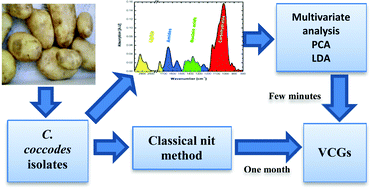Colletotrichum coccodes (C. coccodes) is a pathogenic fungus that causes anthracnose on tomatoes and black dot disease in potatoes. It is considered as a seed tuber and soil-borne pathogen that is difficult to control. C. coccodes isolates are classified into Vegetative Compatibility Groups (VCGs). Early classification of isolates into VCGs is of great importance for a better understanding of the epidemiology of the disease and improving its control. Moreover, the differentiation among these isolates and the assignment of newly-discovered isolates enable control of the disease at its early stages. Distinguishing between isolates using microbiological or genetic methods is time-consuming and not readily available. Our results show that it is possible to assign the isolates into their VCGs and to classify them at the isolate level with a high success rate using Principal Component Analysis (PCA) and Linear Discriminant Analysis (LDA).
